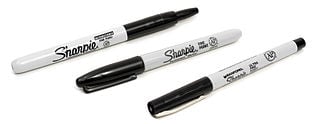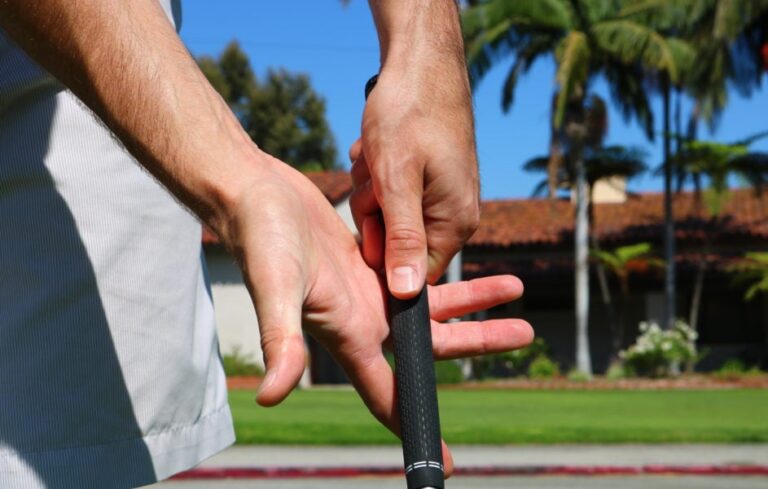
You can’t swing a golf club effectively without a proper golf grip.
There’s no getting around this simple fact.
A consistent golf grip will improve your ball striking, fix your slice, make you more consistent, and give you an all-round better golf game.
Whether you’re getting ready to pure a 300-yard tee shot, or steadying yourself for a two foot putt, you need to know how to handle your club correctly.
It may seem strange to put so much emphasis on your golf grip, I used to think the same thing until I heard the greatest ball strikers crediting consistent grip as the #1 way to improve your ball striking. As Ben Hogan said:

Bad habits can be picked up early in any golfer’s playing days and they often don’t go away.
Think about just how many times you’ll grip a club in your life. Thousands. Tens of thousands. Maybe more. If you want to deliver the club face square onto the ball every time, you’ll need the proper golf grip.
A consistent golf grip is vital to great golf and lower scores.
It’s why some of the greatest golf coaches start with grip and golf stance and don’t move on until their student has fully understood and learned how to hold their drivers, irons, and putter. The same reason why we won’t let you leave here without understanding the same thing.
1. Evaluate Your Current Grip

Before we get a little technical and start showing you the best way to hold your club on the course, you’re going to need to do a little something for us. It’s a small step, but an important one nonetheless…
Now, unless you’re a seasoned pro or an amateur with decades of experience, there’s a very good chance that your game is going to need help. That’s why you’re here. And that’s why we’re here too. Your first step here is to think about your own grip and accept that it may not be perfect.
Picture yourself about to tee off or trying to stick it close on a short par 3.
How do you pick up your club? How do you hold it? What position are your fingers in? How comfortable is it? How confident are you that you’re going to hit a great golf shot?
Is there room for improvement? There is? Great. You’re ready to learn.
2. Grip Size

Your clubs have rubberized grips on them. They’ll be a standardized size. But that doesn’t necessarily mean that they’re the right ones for you. Different size grips exist and they they’re out there for a reason. It could be that you need to invest in some new ones.
For now, stick with the ones you have. Read the rest of this guide and test out your grip.
If you find you are consistently pulling or slicing – despite adapting your hold – you may very well need to consider new grips. Your golf club shop can advise you on a suitable size. It’ll mostly depend on the size and shape of your hands. If you’ve got petite hands and short fingers, smaller grips are required. If you’ve hands like shovels, you’ll want something a little larger.
3. Hand Positioning
It’s time to pick up your club and start perfecting your grip.
Always pick it up in your weaker hand first (left hand for a right handed golfer). Turn your hand over so that you can see two knuckles of your left hand and then point the ‘V’ shape that your index finger and thumb have created towards your right shoulder.

Allowing for about a half inch of the club to poke out of the top of your grip.
Your left thumb should point down the right hand side of the shaft. Now take your right hand and grip the club, with your right thumb sitting on top of your left thumb. Make sure your right thumb sits on the left side of the club, facing downwards.


If this is all a little daunting for you and you’re not confident in your hand positioning, don’t panic. There are special molded grip trainers that can assist. They are molded to instruct you where your hands, fingers and thumbs need to be positioned.
Some even combine a grip trainer with a tempo trainer like this one. It’s perfect to keep at the office or anywhere you want to get some extra practice swings in.
Top pick

SKLZ Golf Tempo & Grip Trainer
This tempo trainer helps improve a golfer’s swing tempo and plane. The training grip provides the correct hand position for the right golf grip, and it has two weight adjustments for iron and wood practice.
Buy on Amazon
4. Get a Sharpie Out

Carry a marker pen like a Sharpie in your golf bag. If you’re not entirely confident about how your club is sitting in your left hand, you can draw two lines on your glove at the correct angles to help. It’ll remind you where the club should be in your grip and give you that little boost of confidence that you’re not misjudging it.
Don’t worry, you’re not breaking any clubhouse or professional rules. It’s perfectly legal to mark your golf glove in this way to assist with your grip. Similar to how marking your golf ball can help you start your putts on line, marking your glove will allow you to guarantee that you’re consistently gripping the club every time you swing it.
5. Interlocking vs. Overlapping Golf Grip

The final piece in the puzzle – position wise – is whether or not to link your hands together with your fingers.
Some players do, some don’t.
However, linking your hands together has become the most prevalent decision amongst golfers in recent years as linking fingers promotes better wrist hinge and a more solid overall grip.
The most common method of finger linking is called ‘The Vardon Grip” or “The Overlapping Grip”. In this grip your hands are joined together by the placement of the right pinky finger being placed in-between the index finger and middle of the left hand.
Now all that’s left to do is align the thumb of your left hand with the middle of your right hand palm.
6. Pressure
As with most things in life, how hard you hold your golf club is all about compromise.
You shouldn’t grasp it so firmly that your knuckles turn white. You’re playing golf, not riding a roller coaster, but similarly you don’t want your grip to be too light that you’ll lose control over your golf club.
If you grip your club too tightly when you play a shot, you may well find yourself delivering the heel of the club onto the ball, instead of the face. Causing inconsistent strikes and a loss of control with every club in your bag. You’ll know if you’re holding on too tightly because as you address the ball, you’ll feel your forearms tense up. Play the shot like that and there’s virtually no chance you play it in a satisfactory way.
Keep your hands gripping softly but firmly. Relax your arms. Waggle the club a little if you like. Sometimes that helps shake off a little tension in the wrists and arms.
7. Keep Things Neutral At First

The grip and technique that we have described to you here is called the “neutral” grip. It’s the most common and natural way to hold a golf club. It makes sense to learn this way and then, later on, when you’re more confident and proficient, you can learn the two other styles. Then you’re adapting your game and improving.
How much you rotate your left hand depends on the “strength” of the grip. If you can see more than two knuckles on your left hand then that’s a “strong” grip and it will close the club face on impact. Rotate your left hand counter-clockwise so no knuckles are visible and that’s a ‘soft’ grip. Which opens up the club face.
You can experiment with the effects of grip “strength” once you’ve mastered the basics. But for now? Keep it nice and neutral.
8. Alternative Grips

We’ve shown you the most popular and ‘approved’ way of gripping your club. But, as with most things, there’s no real cast iron way of doing it. Everyone’s different and some golfers can’t get comfortable with the regular grip. Ultimately, you should do whatever feels natural and comfortable (but that still produces results).
Not everyone grips the way we’ve explained. In fact, some of the world’s top professionals have alternative holds. Take Jordan Spieth, for example.
The Dallas-born superstar holds his clubs like no other pro, proving once and for all that’s there’s no “right or wrong” way to grip a golf club. So long as you know where the club face is and can bring down the thing to hit the ball flush and send it on a nice linear journey towards the hole, you’ve cracked it.
Speith’s grip is certainly unusual. But undeniably top quality. He doesn’t really overlap or interlink his fingers in a way that any other player would recognize. And his grip is pretty weak. He lets his left index finger sit lightly on top of his right hand and only ever so slightly links it with his right pinkie.
If he were a kid going for lessons with a golf tutor, the teacher would get him to ‘correct’ his grip. But there’s no need. He can control the club, knows where the face is and can deliver the head onto the ball perfectly.
It’s not conventional, but it works. After all, you don’t win majors with a lousy grip!
Develop a proper golf grip and improve every aspect of your game…
Are you willing to commit to improving your game?
What would it feel like to turn those frustrating rounds into record lows?
Think about how much better you would play if you could stop worrying about blow-up holes and start making more birdies…

